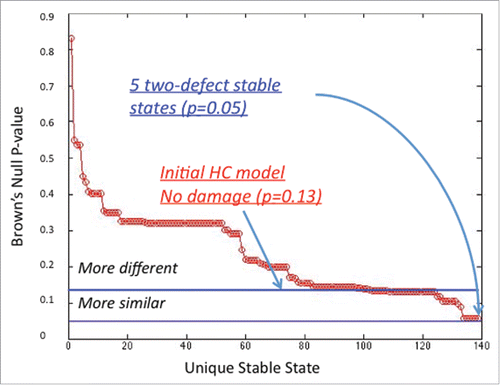Figures & data
Figure 1. A coarse-grained model of endocrine-immune signaling. A coarse circuit logic representation of the principal signals linking the hypothalamic-pituitary-adrenal (HPA) and hypothalamic-pituitary-gonadal (HPG) endocrine axes with innate immune response (IIR) as well as T-helper 1(Th1) and 2 branches of the adaptive immune system as proposed by Craddock et al. (2014).Citation10
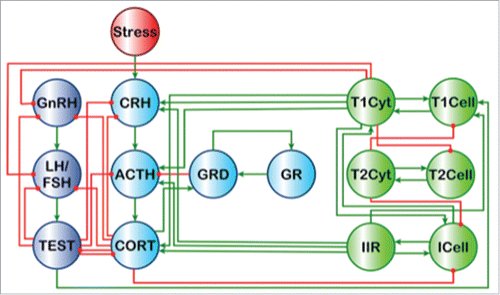
Figure 2. A fine-grained model of immune cell signaling. A detailed circuit logic representation of immune cell signaling including the T-helper 1 (Th-1), 2, (Th2), 17, (Th17) as well as regulatory T-cell signaling (Treg) and their interface with sex and stress hormone regulation as proposed by Fritsch et al. (2013).Citation11
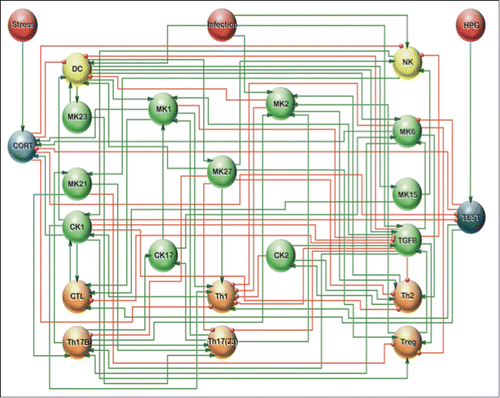
Figure 3. Single defect in HPA-HPG-immune signaling. Statistical difference between observable marker levels in GWI and the alternate steady-state produced in the coarse grained HPA-HPG-Immune model with a single defect to the signaling network. Stable states were identified exhaustively from all possible systems states supported by the network logic such that the system's next allowable state remains unchanged (i.e., x(t+1)=x(t)), or constitutes a state node with a zero out degree (EquationEq. 2(2)
(2) ). A single defect reduces Brown's combined null probability of a difference between GWI and the new modified model from a previous p-value of 0.30 to a value of 0.13 (panel A). This defect corresponds to interruption of normal cortisol-induced suppression of innate cell inflammatory activity (panel B).
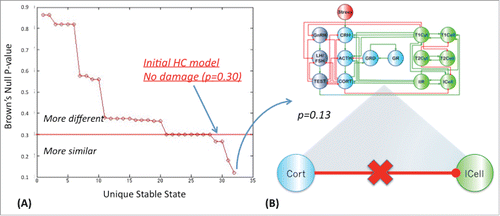
Figure 4. Multiple defects in a coarse-grained signaling circuit. Interrupting two signals at a time in the coarse-grained HPA-HPG-immune network yields 2 solutions, both involving interruption of cortisol suppression of innate inflammatory response. In the first case this is accompanied by the loss of Th1 cytokine inhibition (T1Cyt) of Th2 cell activation (T2Cell) and in the second case by interruption of Th2 cytokine production (T2Cyt) by Th2 cells (T2Cell). As before, stable states were identified exhaustively from all possible systems states supported by the network logic such that the system's next allowable state remains unchanged, or constitutes a state node with a zero out degree. In both cases double interaction deletions produced stable states with a combined null p-value according to Brown's method of p=0 .10 for divergence with observed GWI marker levels.
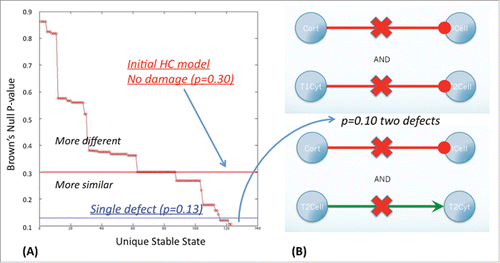
Figure 5. Single compounding defect in detailed immune network circuitry. The statistical difference between observable marker levels in GWI and the alternate steady state produced with the introduction of a single defect in a detailed model of immune cell signaling. This defect reduces Brown's combined null probability of a difference between GWI and the new modified model from a previous p-value of 0.13 to a value of 0.05 (panel A). This defect corresponds to loss of Th1 cytokine (CK1) inhibition of Th2 cell activation (Th2) (panel B). Stable states were identified exhaustively from all possible systems states supported by the network logic such that the system's next allowable state remains unchanged, or constitutes a state node with a zero out degree.
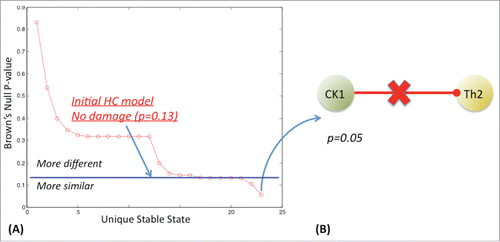
Figure 6. Multiple defects in a detailed immune signaling circuit. Interrupting two signals at a time in the detailed immune network yields 5 stable state solutions. These do not improve the fit to the GWI chronic immune profile over that obtained with a single defect. Of the 3,321 possible double interaction deletions, 74 altered circuits supported stable states with a Brown's combined null p-value of p=0 .05 for divergence with observed GWI marker levels. As before stable states were identified exhaustively from all possible systems states supported by the network logic such that the system's next allowable state remains unchanged, or constitutes a state node with a zero out degree.
